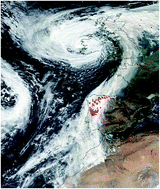Emerging investigator series: the red sky: investigating the hurricane Ophelia Saharan dust and biomass burning aerosol event
Abstract
On 16th October 2017 ex-hurricane Ophelia passed over the UK, bringing with it a unique mixture of particulates which caused the sky to turn a dramatic red colour. Here we use an ensemble of modelling and remote sensing techniques in a ‘top-down, bottom-up’ approach comprising instruments onboard orbital platforms and a ground-based lidar, to interrogate the particle loading to determine its composition and origins. Using a novel, miniature lidar system and back-trajectory modelling to link the measurements to sources, we show that the event comprised two distinct phases, the first dominated by Saharan dust (volume depolarisation ratio at 532 nm; δ = 0.15–0.25) and the second by an optically dense layer, starting at ∼0.7 km, comprising a mixture of Saharan dust and biomass burning particles (δ = 0.08–0.18) originating from intense wildfires in the Iberian Peninsula. CO levels in the weather system were measured as high as ∼273 ppbV and the aerosol index to be >5. Also, the Ophelia system was probed for the first time using multi-spectral imaging data from the Multispectral Instrument (MSI) onboard Sentinel-2. This allowed the differentiation of cloud composition types from above by virtue of the different spectral signatures of the components of the cloud matrix and in doing so gave important supporting evidence to complement the ground-based lidar observations.

- This article is part of the themed collection: Emerging Investigator Series


 Please wait while we load your content...
Please wait while we load your content...